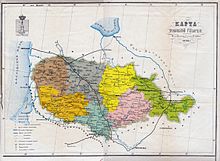Kovno Governorate
The Kovno Governorate ( Russian Ковенская губерния / Kowenskaja gubernija ) was an administrative unit of the Russian Empire . As long as this lasted, it was part of the General Government of Vilnius .
According to today's terms, it occupied about the western half of Lithuania , its main part being the Žemaitėjė landscape . In the south it bordered on East Prussia and within the Russian Empire on the governorates of Courland and Wilna and the Russian-Polish governorate of Suwalki .
It had an area of 40,641 km², the capital was Kovno (Lithuanian Kaunas )
It was formed in 1843 by the division of the Lithuania-Vilna governorate, and the Vilna governorate that was also created was given areas in the south and east. In 1883 there was the Kaunas District Court . The governorate lasted until Lithuania's independence, although de facto it had ceased to exist since the German occupation of western Russia ( Upper East ) in 1915.
Circles
It was divided into seven Ujesdy (circles):
- Kovno
- Novoalexandrovsk (today Zarasai )
- Ponewesch (lit. Panevėžys )
- Rossieny (lit. Raseiniai )
- Schaulen (lit. Šiauliai )
- Telschi ( lit.Telsiai )
- Wilkomir (now Ukmergė )
statistics

According to the 1897 census, the governorate had 1,544,564 inhabitants. Of these, 574,853 were Lithuanians, 444,921 Schmuden , 212,028 Jews, 139,618 Poles, 72,872 Russians, 37,798 Belarusians, 35,188 Latvians, 21,762 Germans, as well as smaller groups of Ukrainians and Tatars.
Agriculture was the main livelihood of the population and was at a relatively high level. At the end of the 19th century, larger projects were undertaken to raise the yield, for example to drain the swamps and improve the livestock population. The harvest in 1902 was 63,0282 tons of wheat, 438,300 tons of rye, 183,134 tons of oats, 109,995 tons of barley, 328,730 tons of potatoes. In addition, the flax cultivation was of greater importance, which was favored by the mild, humid climate. The livestock was 500,000 head of cattle, 330,000 horses, 310,000 (coarse wool) sheep, 260,000 pigs and 100,000 goats. Many geese were also raised. Mining was quite insignificant, industry was still little developed and, with the exception of Kovno and Schaulen, was limited to the processing of agricultural products. In 1893 there were 138 factories with 1,500 workers and a production value of 8 million rubles. The trade extended to grain, flax and wood.

